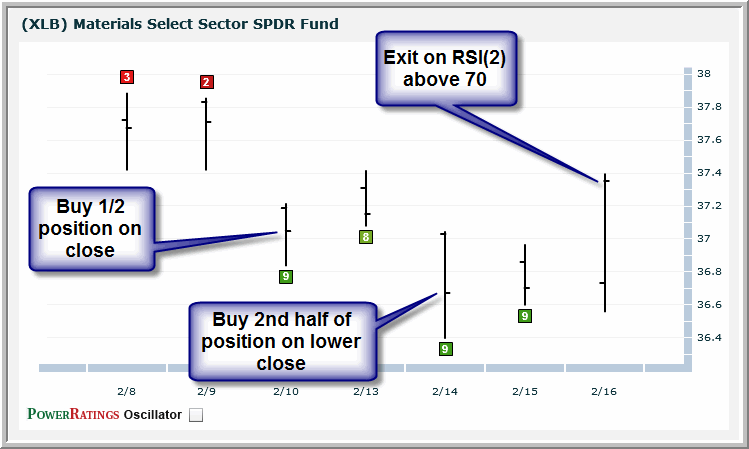ETF of the Week: Materials Select Sector SPDRS ETF
Everyone knows that the key to trading and investing is buying low and selling high. And when it comes to the short-term trading of exchange-traded funds, one of the best quantified strategies for buying low and selling high is called “scaling in.”
To scale into an ETF position, a trader divides his or her basic trading size into two, three or even four parts. For example, a trader who usually allocates $5,000 per position would, in a scale-in scenario, divide that position into, for example, two parts of $2,500 each. Then, instead of buying a $5,000 position all at once, the trader would buy half the position on the first opportunity and look to add the second half if the market in question traded lower while he or she was still in the position.
This strategy allows traders to take advantage of markets that continue to move lower during a sell-off. By scaling in over time – even in a process as simple and straightforward as a two-part scale-in – traders and active investors can potentially increase their accuracy rate, their per trade, win-rate and their ability to maximize the kind of short-term trading opportunites in ETFs that appear almost every day.
The recent pullback in the Materials Select Sector SPDRS ETF (NYSE: XLB), provided yet another example of how to scale-in to a short-term, ETF trade. Here, using PowerRatings and a simple, two-step, scale-in strategy, traders could have bought half a position in the XLB when the ETF earned “consider buying” ratings of 9 out of 10 on February 10. Two days later, XLB again earned “consider buying” ratings of 9 out of 10 but, in closing below the February 10th close, XLB was now available for a further scale-in, and the second half of the XLB position.
Thus, as of February 14, this trader would be long XLB at 37.05 and at 36.67, for a combined position value of 36.86. This is instead of having the full position in XLB at the initial entry price 37.05.

The opportunity to exit the trade in XLB – both halves – came shortly afterwards, as the ETF rallied to finish with a 2-period RSI of more than 70 in just two days. Traders who prefer to use the 5-day moving average as an exit were also able to lock in gains two sessions after adding the second, scale-in position.
For traders using the scale-in approach, gains of more than 1.3% were likely. Without the scale-in, the gains were closer to 0.80%.
Depending on the volatility of the market, the difference between an ETF strategy using a scale-in approach and a traditional all-in buying strategy can be even more significant. And advanced traders who have used three-step or even four-step scale-in strategies (such as those discussed in the TPS section of High Probability ETF Trading: 7 Professional Strategies to Improve Your ETF Trading have often been able to take even greater advantage of these quantified ways buy weakness and sell strength.
To learn more about trading exchange-traded funds using scale-in strategies like these, click here.
And to start trading ETFs using PowerRatings, click the link below to start your free, 14-day, no obligation trial.
Scan Just One Number Tonight … to Find Stocks on the Move Tomorrow
